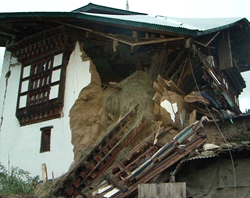His Majesty spoke to residents of Tsento and Doteng, and also listened to their concerns and needs, and urged residents to share their personal experiences during the earthquake. Paro dzongkhag has reported more than 2,100 houses affected by the earthquake, the highest number of any dzongkhag.
“I can’t tell you not to worry,” His Majesty said. “However, I assure you that we, the government, people and king, will work together to restore your lives.”
His Majesty said that he was aware that lack of labour caused by rural to urban migration, and the upcoming harvest season will conflict with repair efforts. His Majesty assured those affected and requiring assistance that the army will be dispatched to aid and reconstruct homes and be provided necessary finances.
Once repair and reconstruction works commence, His Majesty said that he would return periodically to inspect the effort.
During the visit to the two gewogs, His Majesty also entered to inspect some houses that had been deemed too risky for inhabitation.
The head of one household, Kipchu, 54, said the happiness and gratefulness he felt would pass on to his next life by the royal visit. Kipchu, and his family of seven, live in a makeshift structure roofed with tarpaulin, next to their severely damaged house. Kipchu said His Majesty had told him and his family that they would have a home again.
During the interaction with the people of the two gewogs, His Majesty also pointed out that earthquakes are unpredictable and could happen at any time, ranging anywhere from years to days. His Majesty said that the best preparation is to have well constructed and sturdy houses built.
His Majesty the King also pointed that a positive aspect of these tragedies is that “we are all learning from these experiences, and getting more prepared and better skilled to deal with these disasters.”
While saddened by the damage caused His Majesty said, “It warms my heart to see the whole nation, the government and the people working together.” His Majesty added, “We rejoice together, we grieve together.”
By Gyalsten K Dorji
